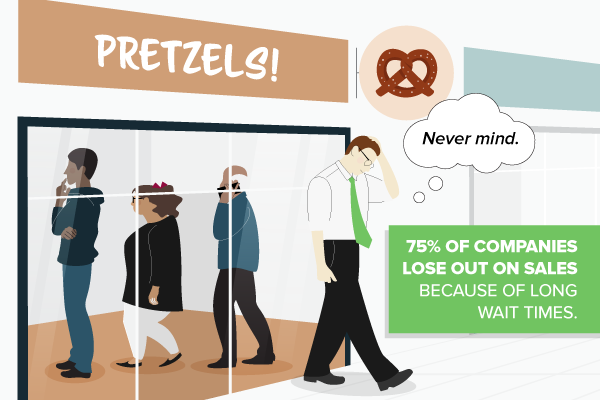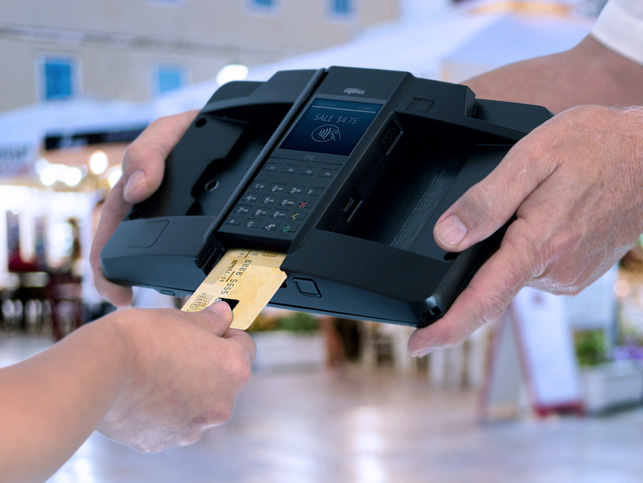The holidays are supposed to be filled with festive cheer as family, friends and relatives are all together from far and near. But in the rush to buy “must have” gifts for kids, spouses and co-workers, there is one other, less enjoyable accessory to Christmas time: lines, and lots of them.
From the supermarket to the airport terminal, the toy store to the fashion boutique, lines are everywhere. You’d be hard pressed to find a single person who actually enjoys standing in line, even if they wait patiently.
“75% of companies wind up losing out on sales when customers go elsewhere because of long wait times.”
But lines aren’t only the bane of customers’ existence – businesses don’t like them either. In fact, according to a study conducted by TimeTrade, 3 in 4 companies wind up losing out on sales when customers decide to go elsewhere as a result of lengthy wait times, often spent in line.

Line-busting saves time, money and frustration
While lines will likely never be a thing of the past, mobile point of sales software is reducing their size and hastening their speed. Through line-busting – taking orders on mobile devices while customers are in line, rather than at a stationary register – business owners are taking advantage of the ability to go to customers right where they are in stores, so people can check out and be on their way.
You name the retail segment – fast food, electronics, home decor and department stores – line-busting has made lines move more quickly, keeping pressed-for-time customers a great deal happier. According to Juniper Research, an estimated 20 percent of worldwide retail transactions will be conducted via mPOS in 2021.

“We are seeing several vendors tailor their software to the needs of specific industries, integrating mobile capabilities as part of broader cloud-based business software,” said Juniper Research’s James Moar, who authored the 2016 report. “These additional services can then make use of the sales data directly to manage inventory, monitor staff performance and other functions, which can all add more value to a business and justify a higher margin.”
Mobile POS is part of the omnichannel movement. Given that customers have more options to buy goods and services – online, app, in-store, etc. – omnichannel makes the purchase process more uniform, so buyers can receive the same type of checkout experience regardless of the medium.
Omnichannel not only provides greater consistency – which is a key component to customer satisfaction – but also frequently leads to more dollar signs. According to a report compiled by Bain & Company, omnichannel customers tend to spend more than those who shop primarily via one channel.
“Amazon is in the midst of testing out cashierless checkout technology that may help customers avoid lines altogether.”
Amazon using cashierless technology
Bringing new meaning to omnichannel shopping is e-commerce giant Amazon. As reported by The Wall Street Journal, Amazon is in the midst of testing out cashierless checkout technology that may help customers avoid lines altogether, charging their online accounts while shopping in an Amazon Go location. These stores are currently confined to Chicago, Seattle and San Francisco, but Amazon may expand to other major metropolitan areas depending on sales performance and the customer feedback the e-commerce giant receives. Amazon Go is also a mobile app, which facilitates purchases via mPOS and tracking technology. Customers simply scan app-generated codes for their purchases, and are free to grab and go thereafter.
Another household name company that’s placing a greater focus on line-busting is Walmart. As reported by Fortune, the big box retailer recently unveiled its Check Out with Me app that enables in-store shoppers to purchase their merchandise without going to the checkout area.
Line-busting paying dividends for small businesses
It isn’t just the retail giants that are finding success with line-busting. The same can be said for small- and medium-sized businesses. In Boston, for example, an award-winning cafe is bringing new meaning to the term “in-and-out dining” by serving up customers’ orders within seven minutes of each individual transaction. It reaches this goal, more often than not, by going to customers right where they are, tablets in hand.
Spoken Cafe, a popular coffee shop in Chicago, uses the same strategy. Owner Will Goodwin couldn’t be happier with the results.
“[Line-busting] has made a huge impact on helping us get through the rush faster,” Goodwin said. “We use handheld tablets to jump through the line and take orders before people get to the counter.” He added that, on average, this form of line-busting has shaved approximately eight-and-a-half minutes off customers’ average wait time during rush hour.
Start eliminating lines with mobile payments today!
Related Articles:
Featured
The stage is set for increased mobile payment adoption. Are your clients equipped to accept NFC payments?
Datacap has recently acquired the payments gateway technology asset from Octopi (formerly Monetary.co). As the new owner of the gateway and gift/loyalty platform, now referred to as NETePay Hosted, Datacap Systems is uniquely positioned as a provider of both in-store and hosted payment solutions…
Hosted Payments Services Providers give ISVs and VARs the technology tools and agility their clients need to do business in an omnichannel world.
Point of sale software delivered via the Software as a Service model gives SMB merchants a budget-friendly, low-risk way to have the POS functionality they need.
The right payments partner can give you and your clients the ability to engineer convenient, loyalty-building customer experiences on every channel.
Cash may be king, but it’s also very costly for businesses. Could integrated payments make sense for your business?
New processing solution from Datacap Systems and EVO Payments simplifies and accelerates EMV migration via ID TECH hardware
Datacap offers ISVs and VARs the opportunity to integrate PCI-validated P2PE and cross-platform tokenization with the point of sale and payment solutions they provide.
Merchants need to ensure consistent experiences as customers transition from e-commerce and mobile to in-store and unattended, especially if they begin their shopping journey on one channel and complete it on another.
POS ISVs and their VAR channels need to answer the persistent question: How do we compete? By analyzing the industry, talking with our partners, and considering the changes end users are facing in their markets, we are convinced the answer is value-added services.













